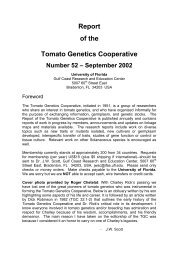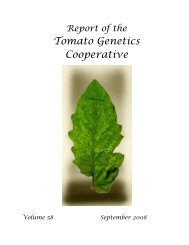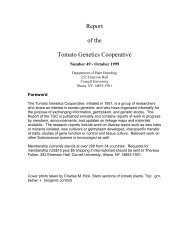Volume 60 - Tomato Genetics Cooperative - University of Florida
Volume 60 - Tomato Genetics Cooperative - University of Florida
Volume 60 - Tomato Genetics Cooperative - University of Florida
Create successful ePaper yourself
Turn your PDF publications into a flip-book with our unique Google optimized e-Paper software.
Revised List <strong>of</strong> Wild Species Stocks<br />
Chetelat, R. T.<br />
TGC REPORT VOLUME <strong>60</strong>, 2010<br />
C.M. Rick <strong>Tomato</strong> <strong>Genetics</strong> Resource Center, Dept. <strong>of</strong> Plant Sciences, <strong>University</strong><br />
<strong>of</strong> California, One Shields Ave., Davis, CA 95616<br />
The following list <strong>of</strong> 1,196 accessions <strong>of</strong> wild tomatoes and allied Solanum species<br />
is a revision <strong>of</strong> the list published in TGC vol. 57, 2007. Other types <strong>of</strong> TGRC stocks are<br />
catalogued in TGC 58 (monogenic mutants) and TGC 59 (miscellaneous stocks).<br />
Inactive accessions have been dropped and new collections added to the present list.<br />
The new material includes populations <strong>of</strong> wild or feral cherry tomato (S. lycopersicum<br />
‘cerasiforme‟) from Mexico (LA4352, LA4353), a stock <strong>of</strong> S. pimpinellifolium containing<br />
the sun gene introgressed from S. lycopersicum, and populations <strong>of</strong> S. peruvianum from<br />
the Azapa valley <strong>of</strong> northern Chile (LA4445-LA4448).<br />
Seed samples will be provided, upon request, for research, breeding or<br />
educational purposes. Some accessions may be temporarily unavailable for distribution<br />
during seed multiplication. In general, only small quantities <strong>of</strong> seed will be provided: 25<br />
seed per accession for the self-pollinated accessions, 50 for the outcrossers or<br />
facultative accessions, and 5-10 for the allied Solanum species. These seed samples<br />
should be sufficient for researchers to produce larger quantities <strong>of</strong> seed, if needed.<br />
Accessions are grown for seed increase in the UC-Davis greenhouses, except for<br />
cherry tomatoes and certain populations <strong>of</strong> S. pimpinellifolium, which are grown in the<br />
field. The population sizes used for seed multiplication depend on the mating system,<br />
and are designed to maintain genetic diversity within accessions (see guidelines at<br />
http://tgrc.ucdavis.edu).<br />
The following tables are ordered by species name, using the classification<br />
system <strong>of</strong> Peralta et al. (2008) 11 , but with the equivalent Lycopersicon names listed as<br />
well. Although only brief collection site data can be presented here, more detailed<br />
records are available from our website, including geographic coordinates, images, and<br />
donor information. An appendix table lists the accessions belonging to the core subsets<br />
for each species.<br />
S. arcanum (L. peruvianum or L. peruvianum var. humifusum)<br />
LA0378 Cascas Cajamarca Peru<br />
LA0385 San Juan (Rio Jequetepeque) Cajamarca Peru<br />
LA0389 Abra Gavilan Cajamarca Peru<br />
LA0392 Llallan Cajamarca Peru<br />
LA0441 Cerro Campana La Libertad Peru<br />
LA1027 Cajamarca Peru<br />
11 Peralta, I. E., D. M. Spooner, S. Knapp (2008) Taxonomy <strong>of</strong> wild tomatoes and their relatives<br />
(Solanum sect. Lycopersicoides, sect. Juglandifolia, and sect. Lycopersicon; Solanaceae).<br />
Systematic Botany Monographs 84: 1-186.<br />
66





